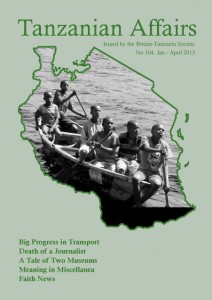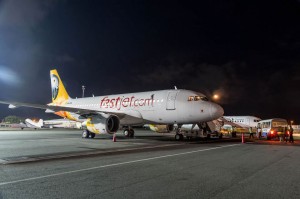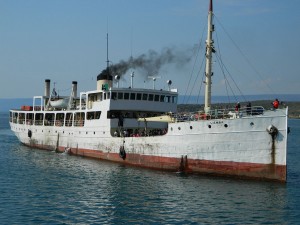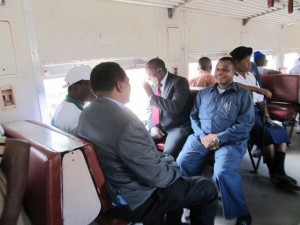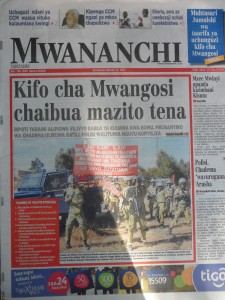While Tanzania’s economy, with the help of its increasing supplies of gas, forges ahead, the country’s agricultural industry receives less notice. In fact, agriculture is finally moving ahead rapidly under the influence of the Government’s ‘Kilimo Kwanza’ policies and also the greatly increased interest in agricultural investment by local and foreign investors. The latter, although very keen to bring in huge sums for investment, are operating in a climate of mounting criticism and suspicion that they are involved in ‘land grabbing’ and forcing peasant farmers off their land. Nevertheless, it is believed that some significant investments are being made. although often in an almost clandestine form. TA has been very limited in its coverage of agriculture and we need a volunteer to join our editorial team to cover at least some of the many exciting developments under way. We mention below a few of these – Editor.
Coffee farmers lined up for support
The German based development finance institution DEG – Deutsche Investitions-und Entwicklungsgesellschaft (German Investment Corporation) – has launched a Coffee Partnership for Tanzania (CPT), to bring together Tanzanian smallholder coffee farmers and DEG with private sector partners. The four-year project aims to increase the net income of 85,000 smallholder coffee farmers by doubling their yields and by improving the quality of coffee produced, thereby providing a better livelihood for up to 510,000 people.
DEG’s Project Director for CPT, Ian Lachmund, said that the project is financed by the Bill & Melinda Gates Foundation through a $ 8 million grant. The project activities include promotion of well-governed farmer groups, training of farmers in basic business and agronomy skills, improvement of farmers’ access to finance and affiliating producers to certification schemes – thereby increasing overall productivity and quality and improving smallholders’ access to stable export markets. “Additional activities in the areas of gender, seedling multiplication and distribution and renewable energy, as well as livestock and food production, will be undertaken to promote the environmental and social sustainability of the partnership,” he said – Guardian.
Agribusiness event
There were some 70 foreign and over 40 local investors at an Agribusiness Investment Showcase in late November. This brought together the government and private sector to display investment opportunities within the Southern Agricultural Growth Corridor of Tanzania (SAGCOT) and to accelerate investment in this sector of Tanzania’s vibrant economy. SAGCOT’s objective is to foster commercially successful agribusinesses to benefit the region’s small-scale farmers, and to improve food security, reduce rural poverty and ensure environmental sustainability via the public-private partnership method. Initiated at the World Economic Forum (WEF) Africa summit in 2010, the aim is an inclusive, multi-stakeholder partnership to rapidly develop the region’s agricultural potential. The founding partners will include farmers, agri-business, the Government of Tanzania, SAGCOT and companies from across the private sector.
The event, held at the Bank of Tanzania (BOT) conference centre, was introduced by Prime Minister Mizengo Pinda. He highlighted the Government’s plan to invest USD 1.3 Billion to leverage about USD 2.1 Billion from the private sector to transform and commercialise smallholder agriculture in Tanzania. He also highlighted the tremendous potential for investment in agribusinesses in Tanzania with 44 million hectares of arable land, of which only about 25% are utilised, together with huge potential for livestock and fisheries development. The event attracted 70 foreign prospective investors and over 40 local companies aiming at taking advantage of investment opportunities within SAGCOT.
Mkulazi project
The government has assured peasant farmers living around the 63,000-hectare Mkulazi Farm that the proposed commercial agriculture investment project would not grab their land. Instead, the government would take precautions to ensure that any land ownership contracts will benefit Tanzanians living in the project area and the country at large.
The Tanzania Investment Centre (TIC) is running an intensive promotion of the Mkulazi area , named the Southern Agricultural Corridor of Tanzania (SAGCOT), to encourage local and international investment aimed at turning the area into a sugarcane and rice production hub. The project would see the construction of two sugar factories with an annual production of 300,000 tonnes, which would end the sugar shortage completely and open doors for large exports.
As various investors visited the area to view the available potentials, villagers who run agricultural activities close by raised concern to government officials over the visitors’ commitment in developing the area and its impact on the lives of the neighbouring community. They said experience had shown that investors packed and left hurriedly after they failed to fulfill targeted obligations, without considering paying their workers, most of whom were residents of the area.
Responding to the concerns, Minister for Agriculture, Food Security and Cooperatives Christopher Chiza said the project was not expected to replace local residents in the area. “Investors will be given 63,000 hectares which will be owned legally by an individual who has submitted an application to TIC for privatisation. No single piece of land from farmers will be grabbed to fulfill investment purposes,” He added: “The government expects a strong partnership between the two sides. They are supposed to depend on each other….farmers should produce crops as raw materials for factories, while investors should guarantee farmers reliable markets.”
Mr Chiza said implementing the project would see development of infrastructure in the area through construction of roads and bridges. the installation of power systems and Tazara Railway services would be improved. Investors would bring technology that would be helpful in transforming traditional agriculture to commercial farming that was valuable in the fight against poverty in the country. “The government, through TIC, will carry out sensitisation meetings at grassroots level, aimed at increasing public understanding of the agenda and translate the available opportunities to a win-win situation,” he said –The Citizen.
Market opportunities
Tanzanian small farmers are among beneficiaries of a $210 million investment fund, promoted by the Export Trading Group (ETG) and aimed at opening market opportunities for traders. It is based in Tanzania and has operations in sub Saharan Africa. It connects smaller farmers to consumers around the world by procuring, processing and distributing agricultural commodities. It sells the goods to countries like China and India – The East African.
Land leases
According to Land Portal, a data base on international land deals, Tanzania has leased more than 1.4 million hectares to foreign companies from Europe and Asia including 100,000 hectares to a Norwegian company for the planting of trees and 45,000 hectares to a British company for the cultivation of sorghum. An American company’s efforts to lease 325,000 hectares in Rukwa region is being disputed because it is said to be threatening the livelihood 160,000 Burundi refugee households.
Cotton and Contract farming
Controversy surrounds discussion about investments in cotton contract farming by ginners and others but the government has stated that rules had to be followed if these were to be successful.
